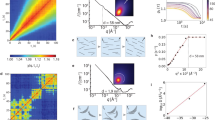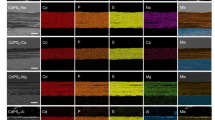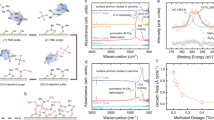Abstract
The physical properties of clays and micas can be controlled by exchanging ions in the crystal lattice. Atomically thin materials can have superior properties in a range of membrane applications, yet the ion-exchange process itself remains largely unexplored in few-layer crystals. Here we use atomic-resolution scanning transmission electron microscopy to study the dynamics of ion exchange and reveal individual ion binding sites in atomically thin and artificially restacked clays and micas. We find that the ion diffusion coefficient for the interlayer space of atomically thin samples is up to 104 times larger than in bulk crystals and approaches its value in free water. Samples where no bulk exchange is expected display fast exchange at restacked interfaces, where the exchanged ions arrange in islands with dimensions controlled by the moiré superlattice dimensions. We attribute the fast ion diffusion to enhanced interlayer expandability resulting from weaker interlayer binding forces in both atomically thin and restacked materials. This work provides atomic scale insights into ion diffusion in highly confined spaces and suggests strategies to design exfoliated clay membranes with enhanced performance.
This is a preview of subscription content, access via your institution
Access options
Access Nature and 54 other Nature Portfolio journals
Get Nature+, our best-value online-access subscription
$29.99 / 30 days
cancel any time
Subscribe to this journal
Receive 12 print issues and online access
$259.00 per year
only $21.58 per issue
Buy this article
- Purchase on SpringerLink
- Instant access to full article PDF
Prices may be subject to local taxes which are calculated during checkout




Similar content being viewed by others
Data availability
All raw data are available from the corresponding authors on request.
Change history
21 September 2021
A Correction to this paper has been published: https://doi.org/10.1038/s41563-021-01134-9
References
Mogg, L. et al. Atomically thin micas as proton-conducting membranes. Nat. Nanotechnol. 14, 962–966 (2019).
Gao, J. et al. Kirigami nanofluidics. Mater. Chem. Front. 2, 475–482 (2018).
Liu, M.-L. et al. Two-dimensional nanochannel arrays based on flexible montmorillonite membranes. ACS Appl. Mater. Interfaces 10, 44915–44923 (2018).
Shao, J.-J., Raidongia, K., Koltonow, A. R. & Huang, J. Self-assembled two-dimensional nanofluidic proton channels with high thermal stability. Nat. Commun. 6, 7602 (2015).
Gao, J., Feng, Y., Guo, W. & Jiang, L. Nanofluidics in two-dimensional layered materials: inspirations from nature. Chem. Soc. Rev. 46, 5400–5424 (2017).
Huang, K. et al. Cation-controlled wetting properties of vermiculite membranes and its promise for fouling resistant oil–water separation. Nat. Commun. 11, 1097 (2020).
Helfferich, F. Ion Exchange (McGraw Hill, 1962).
Nicolosi, V., Chhowalla, M., Kanatzidis, M. G., Strano, M. S. & Coleman, J. N. Liquid exfoliation of layered materials. Science 340, 1226419 (2013).
Nair, R. R., Wu, H. A., Jayaram, P. N., Grigorieva, I. V. & Geim, A. K. Unimpeded permeation of water through helium-leak–tight graphene-based membranes. Science 335, 442–444 (2012).
Stein, D., Kruithof, M. & Dekker, C. Surface-charge-governed ion transport in nanofluidic channels. Phys. Rev. Lett. 93, 035901 (2004).
Alcantar, N., Israelachvili, J. & Boles, J. Forces and ionic transport between mica surfaces: implications for pressure solution. Geochim. Cosmochim. Acta 67, 1289–1304 (2003).
Cheng, L., Fenter, P., Nagy, K. L., Schlegel, M. L. & Sturchio, N. C. Molecular-scale density oscillations in water adjacent to a mica surface. Phy. Rev. Lett. 87, 156103 (2001).
Martin-Jimenez, D., Chacon, E., Tarazona, P. & Garcia, R. Atomically resolved three-dimensional structures of electrolyte aqueous solutions near a solid surface. Nat. Commun. 7, 12164 (2016).
Fuller, A. J. et al. Caesium incorporation and retention in illite interlayers. Appl. Clay Sci. 108, 128–134 (2015).
Brown, G., Nadeau, P., Fowden, L., Barrer, R. M. & Tinker, P. B. Crystal structures of clay minerals and related phyllosilicatÿes. Phil. Trans. R. Soc. A 311, 221–240 (1984).
Klobe, W. D. & Gast, R. G. Reactions affecting cation exchange kinetics in vermiculite. Soil Sci. Soc. Am. J. 31, 744–749 (1967).
Taniguchi, K. et al. Transport and redistribution of radiocesium in Fukushima fallout through rivers. Environ. Sci. Technol. 53, 12339–12347 (2019).
Haigh, S. J. et al. Cross-sectional imaging of individual layers and buried interfaces of graphene-based heterostructures and superlattices. Nat. Mater. 11, 764–767 (2012).
Walker, G. F. Diffusion of exchangeable cations in vermiculite. Nature 184, 1392–1393 (1959).
Sato, H., Yui, M. & Yoshikawa, H. Ionic diffusion coefficients of Cs+, Pb2+, Sm3+, Ni2+, SeO42− and TcO4− in free water determined from conductivity measurements. J. Nucl. Sci. Technol. 33, 950–955 (1996).
Jacobs, D. G. Cesium exchange by vermiculite. In Second Ground Disposal of Radioactive Wastes Conference (eds Morgan, J. M. et al.) 282–291 (US Department of Energy, 1962).
Tester, C. C., Aloni, S., Gilbert, B. & Banfield, J. F. Short- and long-range attractive forces that influence the structure of montmorillonite osmotic hydrates. Langmuir 32, 12039–12046 (2016).
Kleijn, W. B. & Oster, J. D. A model of clay swelling and tactoid formation. Clays Clay Miner. 30, 383–390 (1982).
Ishikawa, R. et al. Direct imaging of hydrogen-atom columns in a crystal by annular bright-field electron microscopy. Nat. Mater. 10, 278–281 (2011).
Sakuma, H. & Kawamura, K. Structure and dynamics of water on Li+-, Na+-, K+-, Cs+-, H3O+-exchanged muscovite surfaces: a molecular dynamics study. Geochim. Cosmochim. Acta 75, 63–81 (2011).
Lee, S. S., Fenter, P., Nagy, K. L. & Sturchio, N. C. Monovalent ion adsorption at the muscovite (001)–solution interface: relationships among ion coverage and speciation, interfacial water structure, and substrate relaxation. Langmuir 28, 8637–8650 (2012).
Lee, S. S., Fenter, P., Nagy, K. L. & Sturchio, N. C. Real-time observation of cation exchange kinetics and dynamics at the muscovite-water interface. Nat. Commun. 8, 15826 (2017).
Esfandiar, A. et al. Size effect in ion transport through angstrom-scale slits. Science 358, 511–513 (2017).
Briggs, N. et al. Atomically thin half-van der Waals metals enabled by confinement heteroepitaxy. Nat. Mater. 19, 637–643 (2020).
Alexeev, E. M. et al. Resonantly hybridized excitons in moiré superlattices in van der Waals heterostructures. Nature 567, 81–86 (2019).
Roger, M. et al. Patterning of sodium ions and the control of electrons in sodium cobaltate. Nature 445, 631–634 (2007).
Hunter, J. D. Matplotlib: a 2D graphics environment. Comput. Sci. Eng. 9, 90–95 (2007).
Hjorth Larsen, A. et al. The atomic simulation environment—a Python library for working with atoms. J. Phys. Condens. Matter 29, 273002 (2017).
Koch, C. T. Determination of Core Structure Periodicity and Point Defect Density Along Dislocations. PhD thesis, Arizona State Univ. (2002).
Acknowledgements
The work was supported by EPSRC grants EP/M010619/1 (S.J.H.), EP/P00119X/1 (R.R.-N., K.S.N.), EP/S021531/1 (S.J.H.) and EP/P009050/1 (S.J.H, D.G.H.), the European Research Council (ERC) under the European Union’s Horizon 2020 research and innovation programme (Grant ERC-2016-STG-EvoluTEM-715502 (S.J.H., Y.-C.Z.), the ERC Synergy Hetero2D project 319277 (K.S.N., Y.-C.Z.) and ERC contract 679689 (R.R.-N)) and The Royal Society (M.L.-H., R.G.), Graphene Flagship (K.S.N., R.G.). L.M. acknowledges the EPSRC NOWNano programme for funding. The work was supported by the Henry Royce Institute for Advanced Materials, funded through EPSRC grants EP/R00661X/1, EP/S019367/1, EP/P025021/1 and EP/P025498/1 (equipment access). We thank the Diamond Light Source for access and support in use of the electron Physical Science Imaging Centre (Instrument E02 and proposal numbers MG21981, MG21597 and MG24290) that contributed to the results presented here (S.J.H.). We thank L. S. Campos from Brasil Minerios for sourcing vermiculite. Part of this work was supported by the Flemish Science Foundation (FWO-Vl) (F.M.P.) and the Sun Yat-sen University 29000-18841290 (Y.-C.Z.).
Author information
Authors and Affiliations
Contributions
S.J.H., M.L.-H. and Y.-C.Z. designed the project. Y.-C.Z., L.M., N.C. and G.-P.H. conducted the sample preparation under the supervision of S.J.H., R.G and M.L.-H. The (S)TEM experiments, image processing and analysis were performed by Y.-C.Z., S.J.H., Y.-C.W. and N.C. STEM image simulations were conducted by Y.-C.Z. and D.G.H. Theoretical support was provided by F.M.P., C.B. and S.M. Synthesis of vermiculite laminates and measurement of their ion-exchange behaviour was performed by R.R.-N. and V.S. The manuscript was written by Y.-C.Z., M.-L.H. and S.J.H. S.S., R.G. and K.S.N. commented on the manuscript and interpretation of results. All authors contributed to discussions.
Corresponding authors
Ethics declarations
Competing interests
The authors declare no competing interests.
Additional information
Peer review information Nature Materials thanks Benjamin Gilbert, Jiaxing Huang and Jani Kotakoski for their contribution to the peer review of this work.
Publisher’s note Springer Nature remains neutral with regard to jurisdictional claims in published maps and institutional affiliations.
Extended data
Extended Data Fig. 1 Schematic illustrating the procedure of TEM sample preparation.
a–d, Steps used in the preparation of cross-sectional samples. a, Mechanical exfoliation of mica(clay) flakes. b, Ion exchange processes for the selected flakes: electrolyte immersion; then drying in a N2 gas environment and quality inspection by optical microscopy. c, Cover the target flakes with thin graphite to avoid surface damage or contamination. d, FIB lift out of the graphite/SiOX/mica(clay) stack, followed by FIB thinning and S/TEM imaging. e–h, Steps used in the preparation of plan-view samples. e, Mechanical exfoliation of mica(clay) crystals onto a PVA/PPC coated SiOx /Si substrate, followed by dissolving PVA in water to leave a floating PPC/mica(clay) stack. f, Transfer of the PPC/mica(clay) stack by micromanipulation onto a SiNx/Si TEM grid, followed by removal of PPC in solvent to leave a clean and suspended flake. g, Ion exchange and cleaning of the mica(clay) flake on TEM grid. h, STEM and TEM imaging.
Extended Data Fig. 2 EDS characterization for beam sensitive clay/mica samples.
a, ADF-STEM cross-sectional image taken from a Cs exchanged 2L vermiculite sample. Scale bar, 1 nm. b, c Consecutively acquired EDS elemental line profiles along the line I to II (summed vertically for the whole ADF region shown in a). b, EDS line profile from t=0 to t=100 s with t being the EDS acquisition time, total electron fluence of ~1.6×107 e·Å−2. c, EDS line profile collected from t=100 to t=200 s with material having experienced a total electron fluence of ~3.2x107 e·Å−2. The peak values for Cs+ counts are marked by red dashed lines. The lower peak Cs concentration for the second measurement shows that Cs+ diffuses away from the region of interest during STEM imaging (Cs+ counts in b > c). A similar decrease is seen in the Mg concentration. Note that the total dose required for high-resolution STEM EDS elemental mapping is >107 e·Å-2, much larger than the total electron fluence that would amorphize the Cs-vermiculite crystals (105 e·Å-2), and hence it is not possible to perform atomic-scale chemical mapping or quantitative atomic analysis in these clay samples.
Extended Data Fig. 3 Plan-view ADF-STEM images taken from the edge of ion exchanged few-layered muscovite and biotite.
a, Muscovite (Mus), b, Biotite (Bio), both Cs-exchanged for 300 h. Cs+ ions are visible as the brightest yellow dots. The largest penetration depth of Cs+ from the edge into the interlayer space in the crystal (∆P) is indicated, yielding D6L-Mus ~10−11 µm2 s−1, and D4L-Bio ~10−11 µm2 s−1. Scale bars, 5 nm.
Extended Data Fig. 4 Exchange speed characterization of vermiculite samples with different exposure times for Cs+ ion exchange, analysed using XRD.
a, XRD taken from bulk crystals (t being the CsCl solution treatment time). b, XRD taken from the laminates made from exfoliated nanosheets. A right shift of (002) peaks can be observed with increasing exposure time due to the contraction of interlayer spacing caused by Cs+ incorporation. c, Flake thickness distribution in the laminates measured by AFM. Inset, optical image of a typical Mg-vermiculite laminate (membrane). Scale bar, 5 mm.
Extended Data Fig. 5 Comparison of the swelling behaviour for vermiculite crystals of different thicknesses in NaCl solution.
a–d, AFM results for a 2L vermiculite region (outlined by red dashed lines) and a local 1L region (outlined by black dashed lines). a, b, AFM height image taken a, in ambient air and b, in aqueous 0.1 M NaCl. c, d, Corresponding height profiles in air and liquid extracted from the positions of the lines (I, II, III, IV) for c, 2L region and d, 1L region. e–h, AFM results for a 3L vermiculite (green dashed lines) containing a local 1L region (black dashed lines). e, f, AFM height image taken e, in ambient air, and f, in aqueous 0.1 M NaCl. g, h, Corresponding height profiles extracted from the positions of the lines (V, VI, VII, VIII) for g, 3L region, and h, 1L region. i, Statistical results showing the AFM measured height (z) values for vermiculite as a function of N, in ambient air (magenta) and liquid NaCl (blue). Swelling values (∆z) are extracted as height difference in liquid and ambient, with the standard deviation extracted from at least three different measurements. j, Mean swelling values per interlayer as a function of N, calculated as ∆z x (N−1)−1 using ∆z values shown in i. Error bars represent the standard deviation (s.d.) from the mean for at least 3 different samples. Dotted line is a guide to the eye. Scale bars in a, b, e, f are all 200 nm.
Supplementary information
Supplementary Information
Supplementary information, figures, tables and references.
Rights and permissions
About this article
Cite this article
Zou, YC., Mogg, L., Clark, N. et al. Ion exchange in atomically thin clays and micas. Nat. Mater. 20, 1677–1682 (2021). https://doi.org/10.1038/s41563-021-01072-6
Received:
Accepted:
Published:
Issue Date:
DOI: https://doi.org/10.1038/s41563-021-01072-6
This article is cited by
-
Uncovering the predictive pathways of lithium and sodium interchange in layered oxides
Nature Materials (2024)
-
Resolving the intrinsic short-range ordering of K+ ions on cleaved muscovite mica
Nature Communications (2023)
-
Observation of an intermediate state during lithium intercalation of twisted bilayer MoS2
Nature Communications (2022)
-
Electrostatic gating and intercalation in 2D materials
Nature Reviews Materials (2022)
-
Iron-rich talc as air-stable platform for magnetic two-dimensional materials
npj 2D Materials and Applications (2021)



